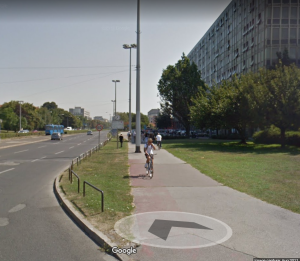Zagreb has more asphalt devoted to cars than I think it needs (or has money to look after). While public transport is actually very good, the core high-capacity tram network does not reach as far as one would expect. Busses cover many routes but suffer from the plague of cities: cars.
Please don’t misunderstand – I’m a car person. I like them as objects, I like fixing them, I like driving. I don’t think they are best suited to dense urban areas however. I think they take space away from people in places where space is already at a premium. They are also a pretty bad way to get around at the time when most other people also have somewhere to be. Bikes would be a great alternative.
Zagreb has nearly ideal geography to become a great cycling city. In the parts of town where the vast majority of people work and live, the topography is very nearly flat. The weather is also milder than even Paris – the headline “new cycling capital”. But cycling is severely underutilised as a transit mode.
This is not to say that there is no cycling infrastructure – there is. It’s just not very well connected to the places people want or need to go. It is also unsafe. Bike paths are narrow and often end suddenly – into a lamp post as in the picture below on Vukovarska (street view from 2011, because I’m not in that part of town now; don’t worry it’s still like that) or merging as a cycling gutter onto a road with a posted speedlimit of 60 (which half the drivers really see as a minimum speed). Cycling modal share will not increase if people feel unsafe cycling.

Of course, there’s a cycling strategy (from the previous mayor’s era) and there are articles about renewed momentum. And education campaigns. And yet there are many 3 lane throughways in the core city that could be cheaply converted for cycling without severely impacting traffic. Those stroads have a speed limit of now 50 or above – drop it to 40 – car journey duration will probably not go up, as the lower speed frees up capacity.
I’d really like to cycle to most places I need to go. Driving is expensive (even before inflation), and the tram only goes halfway half the time. What bugs me, and this is universal – I have plenty of the same things to say about Turku/Finland as well) – is that cheap solutions that can be implemented quickly are overlooked in favour of (expensive) additional infrastructure. More infrastructure means more to maintain too. If repurposing existing infra for 20% of the cost achieves 80% of the effect is so difficult, imagine how much over budget and complicated the dedicated entirely new build infrastructure will be!
Car travel will get it’s own post at some point – there are many intersections here that will magically send you away from where you want to go because you didn’t change lane twice three kms ago.
I’ll come back to the theme of low cost-high impact with infrastructure in future posts. And as a general caveat: I’m not at transit engineer. In fact, I’m not an engineer of any sort! And certainly, there will be some details I’ve overlooked, or complications I’m not aware of. I’m opinionated and I think my views have merit, but I’m willing to be wrong. And I’m also happy for you to tell me that I am, and why. Don’t forget the why – I want to hear your arguments!*
* Please present them in a civil way – if you’re going to troll…
** oh, and if I get round to it ill add some links and stuff. now need to do something else.